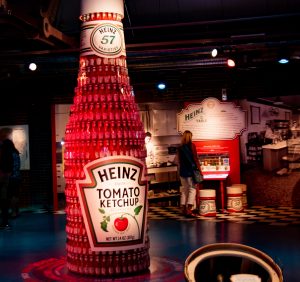It Takes a Burgh to Build the World’s Best Airport
To get started, an international team of experts hit the neighborhoods to meet – and eat – with the locals
By Sue Cardillo
Published November 9, 2018
Read Time: 4 mins
On a dark, rainy August morning, a chartered bus pulled up in front of Pamela’s P&G Diner, in Millvale, about four miles from downtown Pittsburgh.
The restaurant, a local favorite known for its plentiful portions and hotcakes as big as a plate, sits inside a working drugstore, with booths and tables in one corner and the prescription counter on the far wall. Shelves of pain relievers, cough syrups and other pharmaceutical items are within easy reach of both diners and drugstore patrons.

The Heinz History Center is a proud affiliate of the Smithsonian Institution.
The passengers on the bus arrived at 8 a.m., just as the restaurant was opening. Inside, the dark wood and black-and-white checkered floor evoked a Norman Rockwell painting straight out of the 1940s.
This was no regular coffee klatsch of Pittsburgh locals, but a group of world-renowned designers, planners, engineers and architects whose job is to design and build the new terminal at Pittsburgh International Airport.
They came from as far away as Spain and Portugal, gathering for a series of collaborative sessions to build relationships and generate ideas for the project, known officially as the Allegheny County Airport Authority’s Terminal Modernization Program, or TMP.
But the experts also were in town for a little Pittsburgh immersion. During their stay, they toured some of Pittsburgh’s 90 neighborhoods and dined at several venues, including Mallorca on the South Side, CURE in Lawrenceville, Gaucho in the Strip District and, of course, Pamela’s.
“You can form teams for any project, and it becomes a project,” said Ty Osbaugh, an architect with Gensler & Associates and project manager of the TMP. “What’s being done here is a grassroots coming-together where everyone shares the common values that we are trying to create something unique.
“By having everyone come together to explore the city, to get to know each other in a much more casual environment before we start the project, is going to enable us to get a better product at the end,” he said.
Collaboration key to reflecting the region
Collaboration is the key to a high-performing team, said Paul Hoback, senior vice president, Engineering, Planning and Capital Development for the Allegheny County Airport Authority.
“We selected the best groups in the world. How to make them all work together is key,” he said. “In addition to immersing the team in Pittsburgh’s culture, learning how to work collaboratively was a major reason we chose to bring them all together before the project officially got underway.”
The Airport Authority hired San Francisco-based Gensler & Associates and Omaha, Neb.-based HDR to design and deliver the TMP. Both firms have offices in Pennsylvania, with Gensler in Philadelphia and HDR in Pittsburgh. To develop the architectural design vision for the new terminal, Gensler and HDR formed an association with luis vidal + architects, based in Madrid, Spain.

Pittsburgh is ranked as the 2nd most livable city in the U.S. and 32nd in the world, according to the Economic Intelligence Unit.
“Bringing this team together was so important from a design and delivery perspective. It was important for them to understand what’s at stake for the region,” said Christina Cassotis, CEO of Pittsburgh International Airport. “We care very much that the design and execution reflect the region in terms of the sensibilities here, the history, the future, as well as the sense of collaboration that we have among all of the organizations involved in the project.”
Luis Vidal, founder of luis vidal + architects, reflected on the challenge ahead.
“The process of designing such a complex building like an airport and actually making it part of a place that the region embraces and a place where people feel they belong — it’s a very complicated process,” he said.
“We use what the city has to give us. In this case, a spectacular quality of natural light, all the greenery, all the cleanliness, all the friendship, all the openness. We work with elements like color and texture and acoustics and intuitive way-finding to make the building very approachable and very open to represent what Pittsburgh is.”
Audrey Russo, president & CEO, Pittsburgh Technology Council, was among more than 18 community leaders who met with the team.
“The airport is the window into the community,” Russo said. “What was important about the three days of immersion for the people who participated is to understand not just how we work, but also what the fabric is here, and it’s not always apparent to the naked eye.”
The task ahead is not simply to design a new airport or expand an existing airport. The TMP aims to design a terminal that will be the world’s best airport in terms of efficiency and passenger experience.
“The opportunity is immense when you look at what we’re trying to do,” said Gensler’s Osbaugh. “In some ways, it’s to change the world.
“Pittsburgh is a city that’s evolving, and why shouldn’t the airport be that?” he asked. “There are so many hidden nuggets that we’ve been exploring in Pittsburgh. As you come through the airport, why couldn’t you find something that’s just absolutely magical that takes people outside of what they expected and really gives them a unique feel? That’s what we’re trying to create.”
Watch
This Next
Read
This Next





